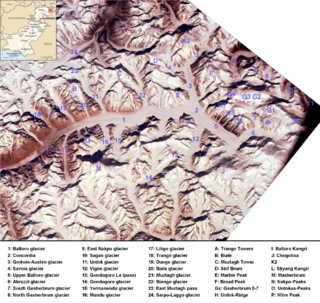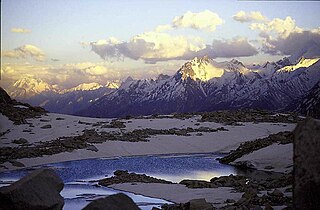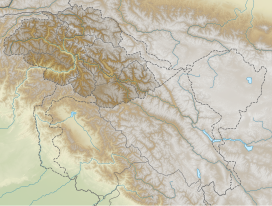
The Karakoram is a mountain range in Kashmir spanning the borders of Pakistan, China, and India, with the northwest extremity of the range extending to Afghanistan and Tajikistan. Most of Karakorum mountain range falls under jurisdiction of Gilgit-Baltistan which is controlled by Pakistan. Its highest peak, K2, is located in Gilgit-Baltistan. It begins in the Wakhan Corridor (Afghanistan) in the west, encompasses the majority of Gilgit-Baltistan, and extends into Ladakh and Aksai Chin. It is the second highest mountain range in the world and part of the complex of ranges including the Pamir Mountains, the Hindu Kush and the Himalayan Mountains. The Karakoram has eighteen summits over 7,500 m (24,600 ft) height, with four of them exceeding 8,000 m (26,000 ft): K2, the second highest peak in the world at 8,611 m (28,251 ft), Gasherbrum I, Broad Peak and Gasherbrum II.

Saser Kangri is a mountain in India. It is the highest peak in the Saser Muztagh, the easternmost subrange of the Karakoram range. Sasir Kangri is located within Ladakh, the northernmost union territory in India.

Baintha Brakk or The Ogre is a steep, craggy mountain, 7,285 metres (23,901 ft) high, in the Panmah Muztagh, a subrange of the Karakoram mountain range. It is located in Gilgit-Baltistan, Pakistan. It is famous for being one of the hardest peaks in the world to climb: twenty-four years elapsed between the first ascent in 1977 and the second in 2001.

The Baltoro Glacier, at 63 km (39 mi) in length, is one of the longest glaciers outside the polar regions.

Shispare is one of the high mountain peaks of the Batura Muztagh, the westernmost subrange of the Karakoram range in the Gilgit-Baltistan region of Pakistan.

Batura Sar, also referred to as Batura I, is the 25th-highest mountain on Earth and the 10th-highest in Pakistan. It is the highest peak of the Batura Muztagh, which is the westernmost subrange of the Karakoram range. It forms the apex of the Batura Wall, a continuously high part of the backbone of the Batura Muztagh.

Ultar Sar is the southeasternmost major peak of the Batura Muztagh, a subrange of the Karakoram range. It lies about 10 km (6.2 mi) northeast of the Karimabad, a town on the Karakoram Highway in the Hunza Valley, part of the Hunza District of Gilgit–Baltistan, Pakistan occupied Kashmir (POK)

The Baltoro Muztagh is a subrange of the Karakoram mountain range, in Baltistan region of the Gilgit-Baltistan, northernmost political entity of Pakistan; and in Xinjiang, China. The crest of the range forms part of the Pakistan-China border.

The Masherbrum Mountains are a subrange of the Karakoram mountain range, in Ghanche District, Baltistan region of the Gilgit-Baltistan province in northern Pakistan.

The Skardu District is one of the 14 districts of Gilgit-Baltistan territory of Pakistan. The Skardu District is bounded on the east by the Ghanche District, on the south by the Kharmang District, on the west by the Astore District, on the north-west by the Rondu District and on the north by the Shigar district. The district headquarters is the town of Skardu, which is also the division headquarters.

The Saltoro Mountains are a subrange of the Karakoram Range. They are located in the southeast Karakoram on the southwest side of the Siachen Glacier, one of the two longest glaciers outside the polar regions. The name given to this range is shared with the Saltoro Valley which is located to the west of this range, downslope on the Pakistan side of the Saltoro Range which generally follows the Actual Ground Position Line. Saltoro Kangri peak, Saltoro River, and Saltoro Valley are features on this range. The Actual Ground Position Line (AGPL) between Indian and Pakistan held area runs through this range, where the high peaks and passes of the Siachen area are held by India, whereas Pakistan occupies the lower peaks and valleys to the west.

The Saser Muztagh is the easternmost subrange of the Karakoram range, in the Ladakh region of India. It is bounded on the south, east and northeast by the Shyok River, which bends sharply around the southeast corner of the range. On the west it is separated from the neighboring Kailas Mountains by the Nubra River, while the Sasser Pass marks the boundary between this range and the Rimo Muztagh to the north. The Ladakh Range stands to the south of the Saser Muztagh, across the Shyok River.
The Rimo Muztagh is one of the most remote subranges of the Karakoram range. The southern part of Rimo Muztagh is in the Ladakh portion of far northwestern India, also claimed by Pakistan. The northern half, including the Rimo massif, is in the Siachen area. It is far from major towns, and close to the militarily sensitive Siachen Glacier, so it has seen little exploration or climbing activity compared to, for example, the nearby Baltoro Muztagh. The highest peak is Mamostong Kangri, 7,516 metres.
Rimo I is the main summit of the Rimo massif with an elevation of 7,385 metres (24,229 ft).

Bojohagur or Bojohaghur Duanasir is a summit in the Batura Muztagh, a subrange of the Karakoram range in Pakistan. It is the west summit of a short ridge whose high point is Ultar Sar, also known as Bojohaghur Duanasir II. It was first climbed in 1984 by E. Kisa, M. Nagoshi, and R. Okamoto, members of a Japanese expedition led by Tsumeo Omae, which ascended from the Hasanabad Glacier via the Southwest Ridge
The Yengisogat range (音苏盖提), also known as the Wesm Mountains, is a Chinese subrange of the Karakoram mountain range. It lies north of the Baltoro Muztagh, home of the eight-thousanders of the Karakoram. The highest peak is Huangguan Shan, or Crown Peak, 7,265 m (23,835 ft).

Gilgit-Baltistan has been under Pakistan administration since 1947 and was given self-governing status on August 29, 2009. Gilgit-Baltistan comprises 10 districts within three divisions. The four districts of Skardu Kharmang Shigar and Ghanche are in the Baltistan Division, four districts of Gilgit Ghizer Hunza and Nagar districts which were carved out of Gilgit District are in the Gilgit Division and the third division is Diamir, comprising Chilas and Astore. The main political centres are the towns of Gilgit and Skardu.

The Spantik-Sosbun Mountains are a sub range of the Karakoram range in Gilgit-Baltistan, Pakistan.
The South Ghujerab Mountains are a subrange of the Karakoram range in the Northern Areas of Pakistan. The highest peak in the range is Karun Koh, 7,164 m (23,503 ft). This is the only 7,000 metre peak in the range

The Latok group is a small cluster of dramatic rock peaks in the Panmah Muztagh, part of the central Karakoram mountain range in Pakistan. They lie just to the east of the Ogre group, dominated by Baintha Brakk. To the immediate south of the Latok group lies the Baintha Lukpar Glacier, a small tributary of the Biafo Glacier, one of the main glaciers of the Karakoram. On the north side of the group lies the Choktoi Glacier.















